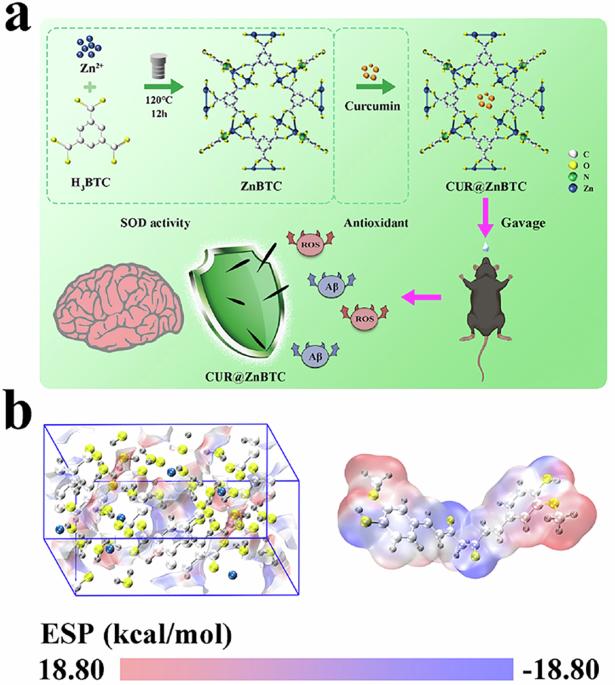Interface potential-induced natural antioxidant mimic system for the treatment of Alzheimer’s disease
IF 5.9
2区 化学
Q1 CHEMISTRY, MULTIDISCIPLINARY
引用次数: 0
Abstract
Although the pathogenesis of Alzheimer’s disease (AD) is still unknown, the molecular pathological phenomena is clear, mainly due to mitochondrial dysfunction and central nervous system inflammation caused by imbalanced antioxidant capacity and synaptic dysfunction, so antioxidant therapy is still the preferred treatment for AD. However, although antioxidant enzymes have high catalytic efficiency, the substrate spectrum is narrow; Antioxidants have wider range of effects, but their efficiency is low. Since the antioxidant defense system in high-grade organisms is composed of both enzymatic and non-enzymatic systems, therefore we synthesized a metal-organic framework (MOF) with superoxide dismutase activity, and depending on the interface potential effect, curcumin was loaded to construct a synergistic antioxidant treatment system. More importantly, due to the complementary surface electrostatic potential between MOF and curcumin, the system exhibited both good antioxidant activity and efficient β-amyloid plaque scavenging ability, which slowed down the cognitive dysfunction in the brain of AD mice. Although the pathogenesis of Alzheimer’s disease (AD) is still unknown, imbalanced antioxidant capacity in nerve cells is a successfully targeted pathological phenomenon in clinical practice. Here, the authors show that the complementary surface electrostatic potential between a metal-organic framework and curcumin results in a complex with good antioxidant activity and efficient β-amyloid plaque scavenging ability, which slows down the cognitive dysfunction in the brain of AD mice.

用于治疗阿尔茨海默病的界面电位诱导天然抗氧化剂模拟系统
虽然阿尔茨海默病(AD)的发病机理尚不清楚,但分子病理现象明确,主要是由于抗氧化能力失衡和突触功能障碍引起的线粒体功能障碍和中枢神经系统炎症,因此抗氧化治疗仍是AD的首选治疗方法。然而,抗氧化酶催化效率虽高,但底物谱狭窄;抗氧化剂作用范围较广,但效率较低。由于高级生物的抗氧化防御系统是由酶系统和非酶系统共同组成的,因此我们合成了一种具有超氧化物歧化酶活性的金属有机框架(MOF),并根据界面潜在效应,负载姜黄素,构建了一个协同抗氧化治疗系统。更重要的是,由于MOF与姜黄素的表面静电电位互补,该体系既具有良好的抗氧化活性,又具有高效的β-淀粉样蛋白斑块清除能力,从而减缓了AD小鼠大脑认知功能障碍。虽然阿尔茨海默病(AD)的发病机理尚不清楚,但神经细胞抗氧化能力失衡是临床上一种成功的靶向病理现象。作者在此研究中发现,金属有机框架与姜黄素之间互补的表面静电势产生了一种具有良好抗氧化活性和高效β淀粉样斑块清除能力的复合物,从而减缓了AD小鼠大脑中的认知功能障碍。
本文章由计算机程序翻译,如有差异,请以英文原文为准。
求助全文
约1分钟内获得全文
求助全文
来源期刊

Communications Chemistry
Chemistry-General Chemistry
CiteScore
7.70
自引率
1.70%
发文量
146
审稿时长
13 weeks
期刊介绍:
Communications Chemistry is an open access journal from Nature Research publishing high-quality research, reviews and commentary in all areas of the chemical sciences. Research papers published by the journal represent significant advances bringing new chemical insight to a specialized area of research. We also aim to provide a community forum for issues of importance to all chemists, regardless of sub-discipline.
 求助内容:
求助内容: 应助结果提醒方式:
应助结果提醒方式:


